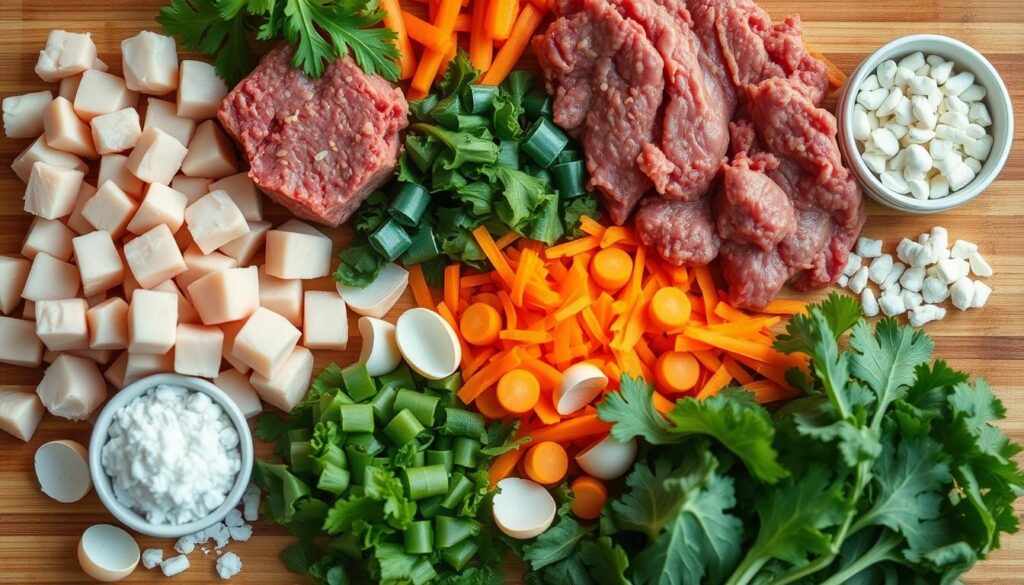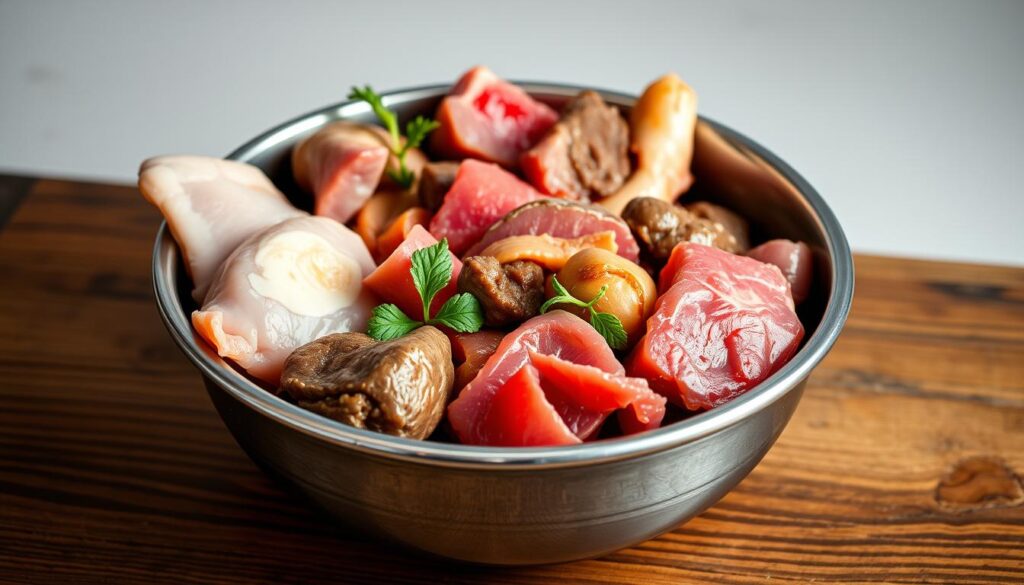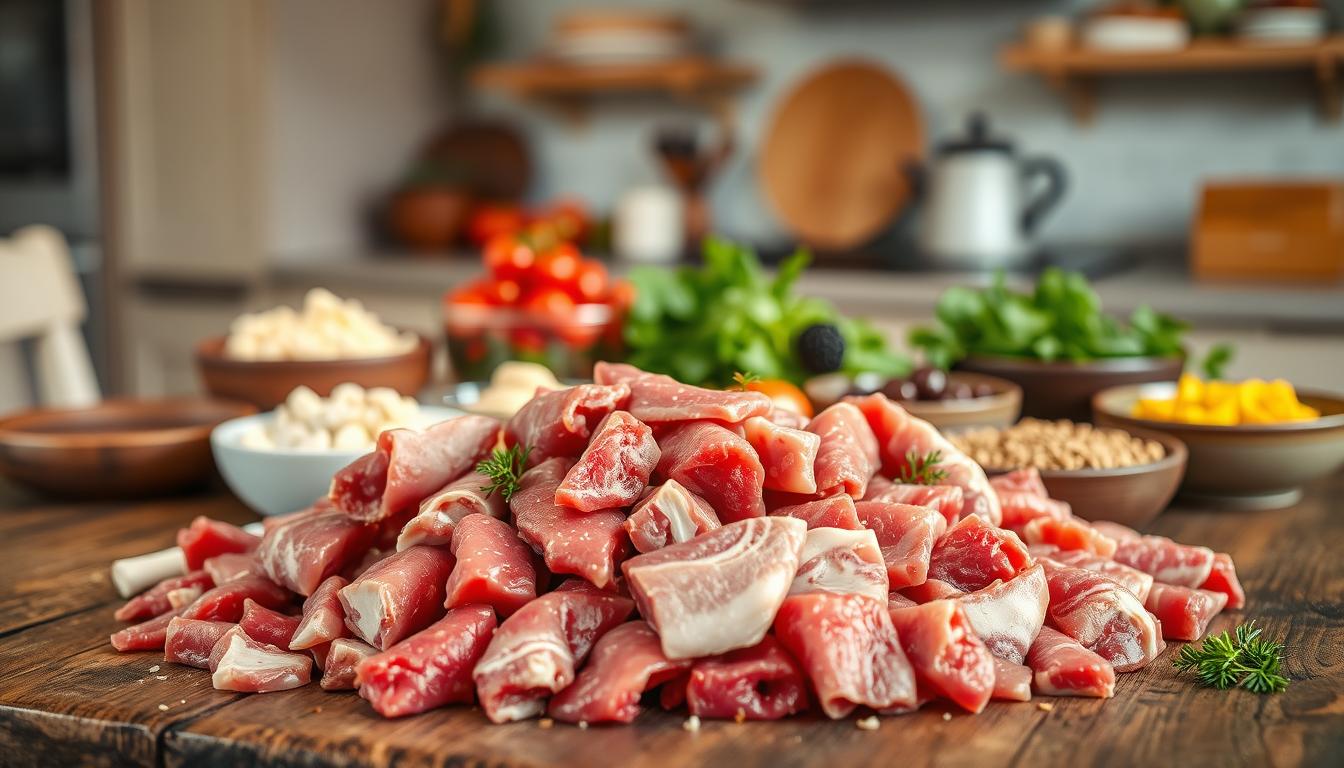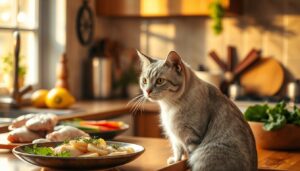As a cat owner, you’re always looking for ways to make your pet healthier. The homemade raw cat food diet is a popular choice. It means making your feline’s meals with fresh, unprocessed foods. This way, you control what your pet eats.
A good raw diet can make your cat healthier. It can also lower the chance of some health problems. Knowing how to plan a healthy cat nutrition plan helps you make better choices for your pet’s diet.
Key Takeaways
- A homemade raw cat food diet can improve your pet’s overall health.
- Using fresh ingredients allows for better control over your cat’s nutrition.
- A well-planned raw diet can reduce the risk of certain health issues.
- Understanding cat nutrition is crucial for making informed decisions.
- A healthy diet can lead to a longer, happier life for your feline companion.
The Natural Diet of Cats: Why Raw Food Matters
Cats are meant to eat raw meat. This gives them the nutrients they need to stay healthy. In the wild, cats hunt and eat their prey. This way, they get all the nutrients they need.
Cats as Obligate Carnivores
Cats need to eat a lot of protein from animals to live. Their bodies are made to digest meat. They have short digestive tracts and lots of stomach acid to break down proteins and kill bacteria.
Nutritional Needs in the Wild vs. Domestication
In the wild, cats get a mix of nutrients from their prey. This includes vitamins, minerals, and fatty acids. Domesticated cats also need these nutrients, but their food often doesn’t have the right mix.
A comparison of nutritional sources is shown below:
| Nutrient | Wild Diet | Domesticated Diet |
|---|---|---|
| Protein | High from animal sources | Often lower, from varied sources |
| Vitamins and Minerals | Balanced from prey | Can be imbalanced, depending on food |
| Essential Fatty Acids | Present in raw meat | May be lacking or supplemented |
Feeding your cat raw food can help meet their nutritional needs. This can improve their health and happiness.
Benefits of a Homemade Raw Cat Food Diet
Feeding your cat a homemade raw diet has many health benefits. It makes their diet more like what they would eat in the wild. This can make them healthier and happier.
Improved Digestion and Nutrient Absorption
A raw diet can make your cat’s digestion better. Raw foods are easier for cats to digest than cooked foods. This means fewer tummy troubles.
With better digestion, your cat may have fewer stomach problems. They also might have a stronger immune system.
Healthier Coat and Reduced Shedding
Cats on a raw diet often have a shinier coat and shed less. Raw foods have lots of protein and healthy fats. These help keep your cat’s skin and coat healthy.
This diet can also help with skin issues and allergies. It makes your cat even healthier.
Dental Health and Reduced Odor
A raw diet is good for your cat’s teeth. It helps prevent tartar and plaque. Chewing on raw bones and meat cleans their teeth and gums.
- Reduced tartar and plaque buildup
- Fresher breath
- Healthier gums
Also, a raw diet can make your cat smell better. They will be more pleasant to be around.
Essential Nutrients Your Cat Needs Daily
It’s important to give your cat the right food for their health. Cats need a lot of protein from meat.
Protein Requirements and Sources
Cats need lots of protein to stay healthy. High-quality protein sources are chicken, salmon, and beef. These give cats amino acids they can’t make themselves.
Make sure protein is at least 30% of your cat’s food.
Fats and Essential Fatty Acids
Fats are key for energy and skin health. Essential fatty acids like omega-3 and omega-6 are very important. Fish oil and flaxseed oil are good sources.
| Fatty Acid | Source | Benefit |
|---|---|---|
| Omega-3 | Fish Oil | Reduces inflammation |
| Omega-6 | Flaxseed Oil | Supports skin health |
Vitamins, Minerals, and Taurine
Vitamins and minerals help with many things like fighting off sickness and keeping bones strong. Taurine, found in meat, is good for the heart and eyes. Make sure your cat gets all these nutrients.
Ingredients for a Balanced Homemade Raw Cat Food Diet
Choosing the right ingredients is key for a homemade raw cat food diet. A balanced diet gives your cat all the nutrients they need for health.
Selecting Quality Meat Sources
Quality meat is the base of a raw cat food diet. Cats need a lot of protein from animal sources.
Poultry Options
Poultry like chicken and turkey are great protein sources. They are lean and easy for cats to digest.
Red Meat Options
Red meats like beef and lamb are good for iron and other nutrients. But, they should be eaten in small amounts because they are rich.
Fish Considerations
Fish is good for omega-3 fatty acids but use it carefully. It can have mercury and cause problems if eaten too much.
Essential Organ Meats
Organ meats are key for a balanced diet. They have vitamins and minerals that muscle meats often lack.
Key Organ Meats:
- Liver: Rich in vitamin A and iron
- Kidneys: High in protein and certain vitamins
- Heart: Provides taurine and other essential nutrients
Supplements and Additives
Even with a good raw diet, some supplements might help. Always talk to a vet before adding anything.
| Supplement | Purpose | Precautions |
|---|---|---|
| Omega-3 Fatty Acids | Supports skin and coat health | Risk of overdose if not properly measured |
| Probiotics | Aids digestion | Choose species-specific probiotics |
| Vitamin E | Antioxidant properties | Can interact with other supplements |

Equipment Needed for Raw Food Preparation
Having the right tools is key for a homemade raw cat food diet. It makes sure the food is good and easy to make.
Essential Kitchen Tools
You’ll need a few basic tools to make raw cat food. A sharp knife and cutting board are must-haves for cutting meat. A meat grinder or food processor helps mix everything well.
Measuring cups and spoons are also important. They help you get the right mix of nutrients.
Storage Containers and Organization
Storing raw meat and other perishables right is very important. Use containers that keep air out to store meals. Label them with dates to remember when they were made.
Keep raw meat separate from other foods. This stops bad germs from spreading. It makes raw feeding for cats safer and easier.
Basic Homemade Raw Cat Food Recipe
A basic homemade raw cat food recipe is key for cat owners. It helps improve your pet’s health. This recipe uses easy-to-find ingredients for a balanced diet.
Ingredient List and Measurements
To make a basic homemade raw cat food, you need:
- 1 pound of raw meat (chicken, beef, or fish)
- 1/2 cup of raw or cooked organ meat (liver, kidney)
- 1 egg
- 1 teaspoon of fish oil
- 1/4 teaspoon of ground flaxseed
- 1/4 teaspoon of dried kelp
These ingredients give your cat the right mix of protein, fat, and nutrients.
Step-by-Step Preparation Instructions
Preparing your homemade raw cat food is easy:
- Grind the raw meat and organ meat together using a meat grinder or food processor.
- Add the egg, fish oil, ground flaxseed, and dried kelp to the mixture.
- Mix well until all the ingredients are fully incorporated.
- Divide the mixture into portions suitable for your cat’s daily meals.
As “The Complete Guide to Raw Feeding for Cats” says, “A well-balanced raw diet can significantly improve your cat’s overall health.”
Storage and Serving Guidelines
To keep your homemade raw cat food fresh and nutritious, follow these tips:
- Store the prepared mixture in airtight containers in the refrigerator for up to 3 days.
- Freeze portions for longer storage, and thaw as needed.
- Serve the raw food at room temperature to preserve the nutrients.
By using this basic recipe and tips, you can give your cat a healthy, homemade raw diet.
Specialized Raw Cat Food Recipes
Creating a raw cat food diet for your cat can really help them feel better. Cats with special health needs, like sensitive stomachs or aging, need special diets. These diets are made just for them.
Recipe for Cats with Sensitive Digestion
Cats with sensitive stomachs need food that’s easy to digest but still full of nutrients. Here’s a simple recipe:
- 1 pound of lean turkey – Rich in protein and easy to digest.
- 1/4 cup of finely chopped liver – Provides essential vitamins and minerals.
- 1 tablespoon of flaxseed oil – Adds omega-3 fatty acids for coat health.
- 1 teaspoon of probiotics – Supports gut health.
Mix everything well and serve. This recipe is gentle on their stomach and gives them all the nutrients they need.
Recipe for Senior Cats with Special Needs
Senior cats need food that helps their joints and keeps them healthy. Here’s a recipe for them:
| Ingredient | Amount | Benefit |
|---|---|---|
| Chicken breast | 1 pound | High-quality protein for muscle maintenance |
| Salmon oil | 2 tablespoons | Omega-3 fatty acids for joint health |
| Eggs | 2 | Additional protein and vitamins |
| Glucosamine supplement | 1 capsule | Supports joint health |
This recipe helps senior cats stay healthy, especially their joints and overall energy.
Transitioning Your Cat to Raw Food
Changing to a raw food diet needs patience and a good plan. This ensures your cat stays healthy and happy. Start slow to make the change smooth.
Gradual Introduction Methods
Mix a little raw food with their usual diet first. Slowly add more raw food over 7-10 days. This helps their body get used to it.
Tips for a smooth transition:
- Watch how their stool and health are doing.
- Change the pace if your cat doesn’t seem okay.
- Make sure the raw food is fresh and safe.
Troubleshooting Common Transition Issues
Some cats might get upset stomachs during the change. If this happens, go slower. Make sure the raw food is good quality and clean.
| Issue | Solution |
|---|---|
| Diarrhea | Slow down transition, check food quality |
| Refusal to eat | Warm the food slightly, mix with familiar foods |

Safety Considerations and Best Practices
Keeping your cat safe is very important. This means being careful with raw meat. You need to watch out for health risks for your cat and your family.
Handling Raw Meat Safely
Keep everything clean when you handle raw meat. Wash your hands well before and after. Make sure all tools and surfaces are clean and germ-free.
Use different cutting boards and tools for raw meat. This stops germs from spreading to other foods. Keep raw meat in sealed bags at the fridge’s bottom. This stops juices from getting on other foods.
Avoiding Harmful Ingredients for Cats
Some foods are bad for cats. Onions, garlic, and chives can hurt their blood. This might cause anemia.
Grapes and raisins can harm a cat’s kidneys. It’s best to keep them away. Chocolate, caffeine, and nuts like macadamia nuts are also bad.
Proper Storage and Thawing Procedures
Storing raw cat food right is key. Use airtight containers or freezer bags. Label them with the date and what’s inside.
Thaw frozen raw cat food in the fridge or cold water. Change the water every 30 minutes. Never thaw it at room temperature or in hot water. This can make germs grow fast.
Monitoring Your Cat’s Health on a Raw Diet
When you switch your cat to a raw diet, watch their health closely. A raw diet can be very good for them. But, you must make sure they are doing well on this new food.
Physical Signs of Improved Health
A cat on a raw diet might look better. They could have a shinier coat and clearer eyes. They might also have more energy.
You might see their digestive health get better too. This could mean firmer stools and less smell.
A good raw diet can really help your cat’s health. Here are some important signs to look for:
| Health Indicator | Expected Improvement |
|---|---|
| Coat Condition | Shinier, healthier coat |
| Energy Levels | Increased energy and vitality |
| Digestive Health | Firmer stools, reduced odor |
When to Consult Your Veterinarian
Even though a raw diet is great, sometimes you need to see a vet. If your cat vomits, has diarrhea, or is very tired, get help. Also, regular vet visits are important to make sure your cat is eating right.
By watching your cat’s health and making changes when needed, they can do well on a raw diet. Talking to your vet often will help make sure your cat gets the best care.
Common Myths and Misconceptions About Raw Feeding
Raw feeding is getting more popular, but it still has many myths. Many cat owners wonder if it’s safe and if it’s good for their pets.
Addressing Safety Concerns
People worry about bacteria in raw food. But, with the right steps, the risk goes down a lot. It’s key to wash hands well and keep raw food in sealed containers.
Using raw cat food recipes with different meats and organs is good. Freezing the food also kills parasites, making it safer.
Debunking Nutritional Myths
Some think homemade pet food lacks important nutrients. But, a well-made raw diet can give cats all they need. It’s important to mix proteins, fats, vitamins, and minerals.
Adding organ meats to your cat’s food is smart. They give important nutrients like taurine and vitamin A. Talking to a vet or animal nutritionist can help make sure your cat gets what it needs.
Knowing the truth can help cat owners make better choices about raw feeding.
Conclusion
Choosing homemade raw cat food can change your cat’s life. It meets their natural needs and boosts their health. Knowing what your cat needs is the first step to a better life for them.
A homemade raw diet has many benefits. It can improve digestion and make your cat’s coat shiny. It also helps their teeth stay healthy. You can pick the best ingredients for your cat’s needs.
When you start your cat on raw food, watch their health closely. Make changes if needed. With time and effort, your cat will be very healthy and happy. Choosing raw food is a great way to make your cat’s life better.
FAQ
What are the benefits of a homemade raw cat food diet?
A homemade raw cat food diet can make your cat’s digestion better. It also makes their coat healthier and their teeth stronger. This diet helps your cat stay healthy and happy.
How do I ensure my cat is getting a balanced diet with homemade raw cat food?
To make sure your cat gets all the nutrients, use different ingredients. Include quality meats, organ meats, and supplements. Talking to a vet or animal nutritionist can help you make a good diet for your cat.
What are some common mistakes to avoid when preparing homemade raw cat food?
Don’t forget to mix nutrients well and handle meat safely. Also, store food right and avoid bad ingredients. These steps keep your cat safe and healthy.
How do I transition my cat to a raw food diet?
Start slow when changing your cat’s diet. Mix a little raw food with their old food. Then, slowly add more raw food over time.
Can I use commercial raw cat food as a substitute for homemade raw cat food?
Commercial raw cat food is easy but not as customizable as homemade. If you’re busy or unsure, it’s a good choice. But homemade food gives you more control.
How do I know if my cat is thriving on a raw diet?
Watch your cat’s health closely. Look at their coat, energy, and stool. If these get better, the diet is working. Regular vet visits also help check your cat’s health.
Are there any specific raw cat food recipes for cats with health conditions?
Yes, there are special recipes for cats with certain health issues. Talk to a vet or animal nutritionist to find the right recipe for your cat.




